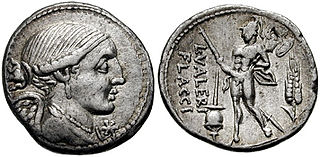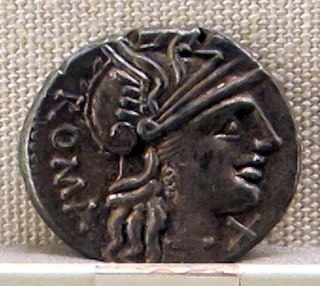Related Research Articles

The gens Petronia was a plebeian family at ancient Rome. This gens claimed an ancient lineage, as a Petronius Sabinus is mentioned in the time of Lucius Tarquinius Superbus, the last of the Roman kings, but few Petronii are mentioned in the time of the Republic. They are frequently encountered under the Empire, holding numerous consulships, and eventually obtaining the Empire itself during the brief reign of Petronius Maximus in AD 455.

The gens Valeria was a patrician family at ancient Rome, prominent from the very beginning of the Republic to the latest period of the Empire. Publius Valerius Poplicola was one of the consuls in 509 BC, the year that saw the overthrow of the Tarquins, and the members of his family were among the most celebrated statesmen and generals at the beginning of the Republic. Over the next ten centuries, few gentes produced as many distinguished men, and at every period the name of Valerius was constantly to be found in the lists of annual magistrates, and held in the highest honour. Several of the emperors claimed descent from the Valerii, whose name they bore as part of their official nomenclature.
The gens Baebia was a plebeian family at ancient Rome. The first member of the gens who obtained the consulship was Gnaeus Baebius Tamphilus, in 182 BC. During the later Republic, the Baebii were frequently connected with the patrician family of the Aemilii.
The gens Papiria was a patrician family at ancient Rome. According to tradition, the Papirii had already achieved prominence in the time of the kings, and the first Rex Sacrorum and Pontifex Maximus of the Republic were members of this gens. Lucius Papirius Mugillanus was the first of the Papirii to obtain the consulship in 444 BC. The patrician members of the family regularly occupied the highest offices of the Roman state down to the time of the Punic Wars. Their most famous member was Lucius Papirius Cursor, five times consul between 326 and 313 BC, who earned three triumphs during the Samnite Wars. Most of the Papirii who held office under the later Republic belonged to various plebeian branches of the family. Although the most illustrious Papirii flourished in the time of the Republic, a number of the family continued to hold high office during the first two centuries of the Empire.

The gens Sempronia was one of the most ancient and noble houses of ancient Rome. Although the oldest branch of this gens was patrician, with Aulus Sempronius Atratinus obtaining the consulship in 497 BC, the thirteenth year of the Republic, but from the time of the Samnite Wars onward, most if not all of the Sempronii appearing in history were plebeians. Although the Sempronii were illustrious under the Republic, few of them attained any importance or notice in imperial times.

The gens Minucia was an ancient Roman family, which flourished from the earliest days of the Republic until imperial times. The gens was apparently of patrician origin, but was better known by its plebeian branches. The first of the Minucii to hold the consulship was Marcus Minucius Augurinus, elected consul in 497 BC.
The gens Aelia, occasionally written Ailia, was a plebeian family in Rome, which flourished from the fifth century BC until at least the third century AD, a period of nearly eight hundred years. The archaic spelling Ailia is found on coins, but must not be confused with Allia, which is a distinct gens. The first member of the family to obtain the consulship was Publius Aelius Paetus in 337 BC.
Caecina Decius Basilius was a politician of the Western Roman Empire, Consul and twice Praetorian prefect of Italy.
The gens Anicia was a plebeian family at ancient Rome, mentioned first towards the end of the fourth century BC. The first of the Anicii to achieve prominence under the Republic was Lucius Anicius Gallus, who conducted the war against the Illyrii during the Third Macedonian War, in 168 BC.

The gens Aufidia was a plebeian family at ancient Rome, which occurs in history from the later part of the Republic to the third century AD. The first member to obtain the consulship was Gnaeus Aufidius Orestes, in 71 BC.
The gens Caecinia was a plebeian family of Etruscan origin at ancient Rome. Members of this gens are first mentioned in the time of Cicero, and they remained prominent through the first century of the Empire, before fading into obscurity in the time of the Flavian emperors. A family of this name rose to prominence once more at the beginning of the fifth century. The poet Decius Albinus Caecina flourished during the reign of Honorius.

The gens Memmia was a plebeian family at ancient Rome. The first member of the gens to achieve prominence was Gaius Memmius Gallus, praetor in 172 BC. From the period of the Jugurthine War to the age of Augustus they contributed numerous tribunes to the Republic.

The gens Pomponia was a plebeian family at ancient Rome. Its members appear throughout the history of the Roman Republic, and into imperial times. The first of the gens to achieve prominence was Marcus Pomponius, tribune of the plebs in 449 BC; the first who obtained the consulship was Manius Pomponius Matho in 233 BC.
The gens Ceionia or Caeionia was an ancient Roman family of imperial times. The first member of the gens to obtain the consulship was Lucius Ceionius Commodus in AD 78. The rise of this family culminated in the elevation of the emperor Lucius Verus, born Lucius Ceionius Commodus, in AD 161.
Caecina Decius AcinatiusAlbinus was an aristocrat of the Roman Empire. He was praefectus urbi in 414, succeeding his friend Rutilius Namatianus, and possibly again in 426.
The gens Rutilia was a plebeian family at ancient Rome. Members of this gens appear in history beginning in the second century BC. The first to obtain the consulship was Publius Rutilius Rufus in 105 BC.
The gens Helvia was a plebeian family at ancient Rome. This gens is first mentioned at the time of the Second Punic War, but the only member of the family to hold any curule magistracy under the Republic was Gaius Helvius, praetor in BC 198. Soon afterward, the family slipped into obscurity, from which it was redeemed by the emperor Pertinax, nearly four centuries later.
The gens Magia was a plebeian family at ancient Rome. Members of this gens are first mentioned at the time of the Second Punic War. Although several of them performed useful service to the Roman state, none of the Magii ever held the consulship.
The gens Numicia was an ancient patrician family at Rome. The first of the Numicii to appear in history was Titus Numicius Priscus, consul in 469 BC. Later members of the family were plebeian. Members of this gens are first mentioned down to imperial times, and the nomen Numicius is regularly confused with Numisius, which was probably nothing more than a different form of the same gentile name.
The gens Rupilia, occasionally written Rupillia, was a minor plebeian family at ancient Rome. Members of this gens are first mentioned in the latter part of the Republic, and Publius Rupilius obtained the consulship in 132 BC. Few others achieved any prominence, but the name occurs once or twice in the consular fasti under the Empire. The name is frequently confounded with the similar Rutilius.
References
- 1 2 Dictionary of Greek and Roman Biography and Mythology, vol. I, pp. 946, 947 ("Decia Gens").
- ↑ Chase, p. 128.
- 1 2 Dionysius, vi. 88.
- ↑ Broughton, vol. I, p. 18.
- ↑ Livy, ix. 30.
- ↑ Brougton, vol. I, p. 161.
- ↑ Livy, xliii. 17.
- ↑ Broughton, vol. I, p. 426.
- ↑ Livy, xlv. 3.
- ↑ Broughton, vol. I, p. 430.
- ↑ Cicero, De Oratore, ii. 31, 62.
- ↑ Aurelius Victor, De Viris Illustribus, 72.
- ↑ Livy, Epitome, 61.
- ↑ Broughton, vol. I, pp. 524, 525 (note 4), 532.
- ↑ Cicero, Philippicae, xi. 6, xiii. 14.
- ↑ Appian, Bellum Civile, iii. 80.
- ↑ Appian, Bellum Civile, iv. 27.
- ↑ Pliny the Elder, Historia Naturalis, xxxiv. 18.
- 1 2 Broughton, vol. I, p. 135.
- ↑ Broughton, vol. I, pp. 159, 164, 166–168, 175, 177.
- ↑ Cicero, De Finibus, ii. 61, Tusculanae Quaestiones, i. 89.
- ↑ Cassius Dio, fragmentum xl. 43.
- ↑ Zonaras, viii. 5.
- ↑ Broughton, vol. I, pp. 192, 193 (note 1).
- ↑ CIL VI, 1659, CIL VI, 1703.
- ↑ CIL XV, 7107.
- ↑ CIL XV, 7420.
- ↑ CIL VI, 1716, CIL VI, 31957.
- ↑ CIL X, 6850, CIL X, 6851.